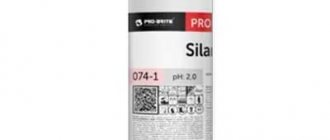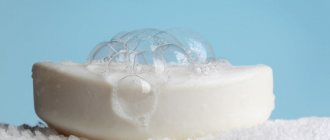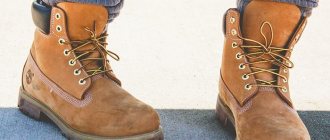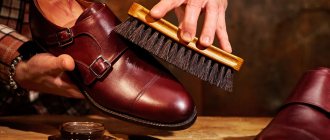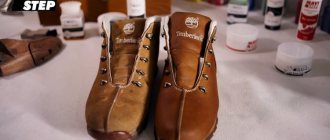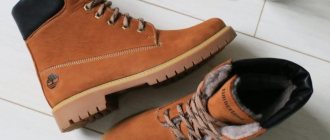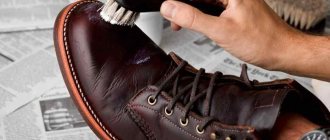You can often find winter or demi-season nubuck shoes in stores, but not everyone buys them. Many people are put off by the cleaning features of such products, but there is nothing to worry about. If you know how to care for nubuck shoes, you won’t be afraid to wear shoes or boots made of this material even in rainy weather. Care is necessary to ensure that the pair lasts as long as possible, otherwise abrasions and stains may appear on it.
Proper care of old nubuck shoes
Natural nubuck is a leather that is distinguished by its high quality and fine-haired surface. Compared to suede, it is more practical and moisture resistant. However, it is inferior to smooth leather in many respects, especially if you do not follow the rules for caring for nubuck shoes. It is recommended to impregnate the products with special products in order to wear them in wet weather and avoid contamination.
Features of care
Nubuck is tanned in one of several ways, and this affects the cost of the product. Tanning is carried out using fats, salts and wood extracts. The material is made from the hides of cattle, such as elk and deer. Consequently, shoes are often expensive, but have increased wear resistance. The cheaper the boots, the faster they will deteriorate. Cleaning old boots is much more difficult, so it is recommended that you familiarize yourself with the secrets of caring for nubuck at home.
Using various tools and tools
Cleaning agents, brushes and sponges will help restore a fresh look to your favorite boots. Care for nubuck is carried out using the following means:
- Collonil Nubuk paint, which can restore shade and prevent stains, comes in colorless, black, brown, blue;
- impregnation that protects the material from snow, rain and dirt (stains are much easier to remove);
- one-, two- or three-sided brush with metal and rubber bristles;
- Collonil Shampoo, which removes stubborn dirt and salt stains (relevant in the winter, when the asphalt is sprinkled with reagents).
In addition, it is possible to use erasers and brushes to clean heels or remove stains on light-colored items. If necessary, you can purchase a deodorant or conditioner that prevents the appearance of an unpleasant odor.
After using dyes, it is advisable to choose products from the same company the next time to avoid different shades. The most popular companies are Shtrikh, Collonil, Saphir, Kiwi, All Combi, Salton.
Instructions
It is necessary to follow the sequence of actions to achieve maximum effect. First you need to clean the boots from dust using a clean damp cloth or a special sponge, then let them dry. They must be dry not only on the outside, but also on the inside.
If there are stains and streaks on the material, they must first be removed with a special solution, eraser or brush. Typically, the shoe instructions indicate whether nubuck can be washed with water or whether dry cleaning is recommended. Be sure to carefully rinse the sole under the tap, but so that no water gets on your skin. Then you need to use shampoo (diluted with water in a ratio of 1:2), applying foam to the surface. Remains of the product are removed with a damp cloth and left to dry. Only after this can you proceed to painting or applying a moisture-repellent liquid.
Coloring aerosols, which are applied to the product and do not wash off, will help to refresh the color. This should be done away from furniture and walls, and the floor should be covered with old newspapers or polyethylene. Spray the paint at a distance of 15-25 cm from the shoes, trying to apply it evenly.
Important! All elements that should not be painted (laces, rivets) are sealed with masking tape.
Nubuck material and its types
Today's “craftsmen” can imitate any natural material. But this does not mean that the artificial version is much inferior in its properties to the original. Sometimes synthetic material is visually and tactilely exactly like natural material, but it is much more practical in operation. Nubuck also has an artificial counterpart, but is it so bad? Let's look at the types of nubuck, their pros and cons.
Natural
Nubuck is a specially treated genuine leather. Compared to smooth leather, it is more attractive in appearance, softer and more pleasant to the touch. Things made from it have an interesting and elegant look. But it is the nuances of manufacturing that make the material permeable to moisture. During the sanding process, the dense top layer of skin is damaged. But this problem can also be solved - there are special compounds for impregnating nubuck, giving it water-repellent properties.
Shoes made from natural nubuck are pliable, easily adapt to the shape of the foot and rarely rub, and most importantly, they “breathe” and at the same time retain heat well. Outerwear fits perfectly, looks impressive and is very pleasant to wear. The price of natural material cannot be low - it is usually more expensive than leather, but cheaper than suede. The main disadvantage is the requirement for care.
Artificial
Here the “velvety” effect is achieved by gradually spraying layers of various polymers on top of each other. The downside is that this material is not porous and does not have the same breathability as natural material. But it also has its advantages:
- moisture and dirt resistance;
- wear resistance;
- low price.
The visual difference between natural nubuck and artificial one is minimal, and the main advantage of the analogue is that it does not require complex care - just brush it with a special brush and treat it with impregnation.
Oiled
Another name is nubuck oil. Natural material is treated with special fats. It acquires water-repellent properties - you can even walk through puddles. The appearance changes slightly: it is heavier, not as soft, and the fibers are less pliable. Nubuck oil is slightly damp to the touch, but also very pleasant. Most often, oiled material is used for sewing premium winter and demi-season shoes. This is understandable - there is no point in protecting your wallet or sandals from moisture.
It would seem that there are only advantages. But no. The cost of oiled nubuck even exceeds the price of natural suede - and this is its main disadvantage.
Caring for new products
Preventing stains is easier than trying to clean them up later. To make your boots last longer, it is recommended to properly care for them from the first day of wear. The same tools will help with this: sponges for gentle care, impregnations that protect against dirt, erasers.
How to care from the first day of purchase
You need to take care of your boots or shoes every day; this determines how long the shoes will last. It is permissible to use products suitable for this material; it is advisable to purchase them in specialized stores. You need to use them on the first day to protect your skin.
Preventative cleaning
It is worth remembering that any processing is carried out only after the product has dried. Under no circumstances should you dry your shoes on a radiator! Such actions will ruin not only the color, but also the shape of the boots. While it is possible to correct the shade at home, even a professional cannot eliminate the deformation.
Every day you need to wipe the soles and surface of your shoes. This can be done with a damp cloth, sponge or soft brush for nubuck (made of silicone or rubber). In case of lack of care, the products will soon lose their rich color, stains and abrasions will appear.
Removing stains and streaks
It is impossible to avoid stains, even if you wear your shoes very carefully. The car got splashed, your foot was stepped on, it got caught in the rain - all this will affect the appearance of the boots. How to properly care for nubuck if it gets dirty:
- dry the boots well using a dryer or newspapers;
- rub the dirty stain with a special eraser (a stationery eraser is not suitable for this);
- If you can’t remove the stain with an eraser, you can try scrubbing it off with a brush.
In cases where erasers and brushes do not help, it’s time to buy shampoo or foam. It is better to resort to them when cleaning a large area is required. If there is no effect, all that remains is to choose a paint or aerosol that matches the color. The last product is sprayed onto the surface from a short distance, and the paint is applied with a sponge. At the end, be sure to treat it with a moisture-repellent spray.
We recommend:
How to remove a handle from a leather sofa at home
Storage rules
It is impossible to imagine the answer to the question of how to care for natural nubuck without recommendations for proper shoe storage. If you want to maintain the visual appeal of the product and simplify the care of moccasins or boots, you need to prepare a pair according to certain rules:
- Send your shoes for storage immediately after the end of the season, do not wait several months;
- Each shoe is placed in a separate fabric bag, together they go into a cardboard box;
- Refuse to use polyethylene - you risk creating high humidity, which will contribute to the appearance of mold and rot;
- Each pair is thoroughly cleaned with special products and completely dried;
- To maintain the shape of your shoes, you can use crumpled newspapers, papers, or specialized spacers.
- If you need to know how to wash sneakers in a machine, then the rules are here.
Following a few simple care recommendations will guarantee the safety of your favorite pairs of nubuck shoes - boots, sneakers or shoes will delight you for many seasons!
Now you know how to care for nubuck - give your shoes a chance for a long life, enjoy everyday shoe wear and get the most from the beauty and comfort of the products! Read on to learn how to clean light suede shoes.
What to do before going out for the first time
Most people ignore caring for nubuck shoes, not considering it important. However, after a few weeks they are trying to save the new shoes, using all kinds of impregnations, paints and tools. It is quite difficult to restore the original appearance.
You need to start taking care of a nubuck product right away, and the seller should notify you about this. You can read the care information on the box with the boots (or on a separate insert in it). Usually it says that the first step is to treat the material three times with an aerosol that protects it from dirt and water. After each layer you will have to wait some time so that the nubuck has time to dry. You can do this on the balcony or bathroom so as not to stain the furniture.
Important! Procedures for applying protective agents or paint are carried out in advance. It is necessary that the shoes have time to dry before going outside, otherwise dust will stick to them.
What is strictly prohibited
- Do not wash nubuck with water or use chemicals. If necessary, it is better to apply shoe foam. Gently wipe the shoes with a washcloth, if necessary, repeat this process 2-3 times.
- Do not wipe with a wet cloth.
- Do not clean or use shoe polish.
- It is not advisable to use shoes when it is raining and snowing outside.
- Avoid cosmetics that contain oil.
Dyeing nubuck
There are many tips on how to properly care for nubuck shoes. There is much less information about painting, which can bring even old boots back to life. It will help disguise small worn areas, as well as refresh the color if the skin has become dull. First you need to try to remove all dirt, cover the metal elements with tape and remove the laces. There are 2 options:
- Dye. Anyone can cope with coloring by studying the instructions for use. It is only important to choose the most suitable shade, remove stains and go over the entire surface with an eraser to remove the greasy layer. Apply the paint with a sponge, sometimes 2 layers are required with intermediate drying.
- Impregnation. Colorless impregnations will restore velvety and elasticity to the skin, and also protect against color loss. If this has already happened, you can choose a tint aerosol. It is easier to apply to the material than paint. It is first necessary to clean the surface from dust and residues of previous products.
Usually, with the right shade, one layer is enough. If a mistake is made when choosing a color, it is better to spray the shoes twice.
What is it made of
In the classical sense, nubuck is made from calfskin using the chrome tanning method; a slight roughness is given to it using a light abrasive treatment. Nubuck differs from suede in its finer hairiness and special polishing, which gives it a worn look. Today there are at least three types of materials:
- Natural, made from full-fledged leather, has its advantages, but requires more careful care.
- Artificial, it is made from synthetic materials, in several layers, such nubuck is stronger than natural, waterproof, but does not have “breathable” properties, and is practically no different in appearance from natural one.
- Nubuck oil, genuine leather, impregnated with water-repellent agents, it is easy to care for, more durable, and pleasant to look and feel.
So, let's figure it out in order: how to wear such shoes correctly, what care products are available, how to properly wash, dry and store them.
How to avoid damaging your shoes
The seller should tell you whether nubuck can be washed under water, but it is still not advisable to wet or clean wet products. The material is deformed and loses its properties, so it must be thoroughly dried before processing. Do not use creams or aerosols intended for smooth skin. Moreover, you cannot wash products in soapy water or hair shampoo. The foam is difficult to wash out, which is why stains remain and the structure of nubuck deteriorates.
It is recommended to store shoes or boots in fabric bags or boxes; plastic bags are not suitable. Before you put them away for the summer or winter, you should clean them, removing all dirt.
Any shoes require regular treatment, but caring for nubuck shoes includes several stages. These include cleaning the product with brushes or shampoos, applying protective liquids, and even painting.
Rate this post
Difference with suede
The difference is in the origin and method of tanning the leather. The table clearly shows how nubuck differs from suede and what their performance properties are.
Table - Differences between suede and nubuck
| Options | Suede | Nubuck |
| Tanning | — Fats of vegetable and animal origin | — Mineral salts (chromic) followed by grinding of the top layer |
| Leather | — Small cattle | — Cattle |
| Extensibility | — High | — Average |
| Waterproof | — Average | — Low |
| Shock resistance | — Average | — High |
| Wear resistance | — Average | — High |
| Area of application (most common) | - Outerwear; - bags; - hats; - wallets; - shoes (rarely) | - Shoes; - bags; — belts; - jackets; - furniture |
Fun fact: Most “suede” shoes are actually made from nubuck. Due to its softness and high stretchability, suede is not used in clothes without a thick lining. It is used very rarely for sewing shoes - the material quickly deforms and reacts sensitively to deicing agents. But for jackets, wallets and bags - just right. But suede at a low price is most likely nubuck.
Nubuck or leather: which is better?
Nubuck
There is also no clear answer to the question of what is better - nubuck or smooth leather. Both types of material perfectly retain heat and are durable. Both leather and nubuck boots look impeccable, stylish and expensive.
- But the difference is that calfskin products can retain their original appearance for much longer. They are less susceptible to creases, of course, if you care for them properly.
- Leather boots, unlike nubuck ones, do not allow water to pass through. Therefore, they are perfect for wearing in wet weather. They are not negatively affected by precipitation or temperature changes.
This comparative description of both types of leather shoes will help you make the right choice. But if there is such an opportunity, it is better to purchase both pairs at once in order to have an alternative for any weather.
Cleaning boots correctly
To preserve the integrity of the top layer of the pair as much as possible, you need to adhere to a clear sequence:
- To remove dust, use a special sponge and a well-wrung out soft cloth.
- Drying the boots is a requirement for the top layer and insoles.
- To get rid of streaks and stains, first treat the problem area with a brush, then you can use a special eraser for nubuck. A solution of vinegar and water in a ratio of 1:3 will help remove the stain.
- Pumice - An abrasive stone can be used with caution to remove tough stains. There is a risk of scuffs and loss of the original shade.
- Shampoo - for severe stains, prepare a solution of 1 part detergent and 2 parts water. Beat until a dense foam forms and apply to boots. Remove with a soft cloth and dry.
- Painting, if necessary, is done using aerosols that do not need to be washed off.
- Application of water-repellent composition.
When cleaning, do not press hard on the nubuck, as you can crush the pile too much and damage the integrity of the leather. Be sure to remove any remaining dirt in the gaps of the seams and avoid prolonged contact with water. Read the label on your shoes; some models can only be dry cleaned.
Proper handling of natural leather
Nubuck is a capricious material, so it is unacceptable not to spoil it:
- Dry near heating devices - deformation, cracks.
- Use plastic bags for storage - ventilation must be provided so that the skin can breathe.
- Cleaning a pair until it is completely dry will aggravate the degree of contamination; reagents and dirt will penetrate deeper into the pores of the nubuck.
- Apply special care compounds directly to shoes, except for aerosols. Distribute the product over a sponge, brush, and gently rub into the skin.
- Use regular soap for care, hair shampoos - aggressive alkali, parabens, chemical additives form stains and stains, they are difficult to remove.
Nubuck does not tolerate washing under running water. This will cause the pile to become knocked down, the skin pores will not allow air to pass through well, and the color will fade.
How to distinguish real nubuck from artificial?
Real natural nubuck
It is actually very simple to distinguish genuine leather from fake leather - artificial nubuck, and you can do this both at home and in the store. More details:
- Pay attention to the tag. If the shoes are natural, then the tag will be made of the same material. In addition, there will be a mark with an animal figure on it.
- Regarding shoes made from artificial nubuck, the tag in this case can be completely different - from paper, cardboard, cotton rag.
- The presence of synthetic material is indicated by a diamond.
Now about the test that you can do at home. Nubuck is distinguished by its ability to quickly absorb moisture, but its substitute, on the contrary, repels it. Therefore, moisten the surface of the product with water and observe. If the liquid is quickly absorbed, you have shoes made of genuine leather, but this feature is unusual for artificial raw materials, so it will not be difficult for you to recognize them.

